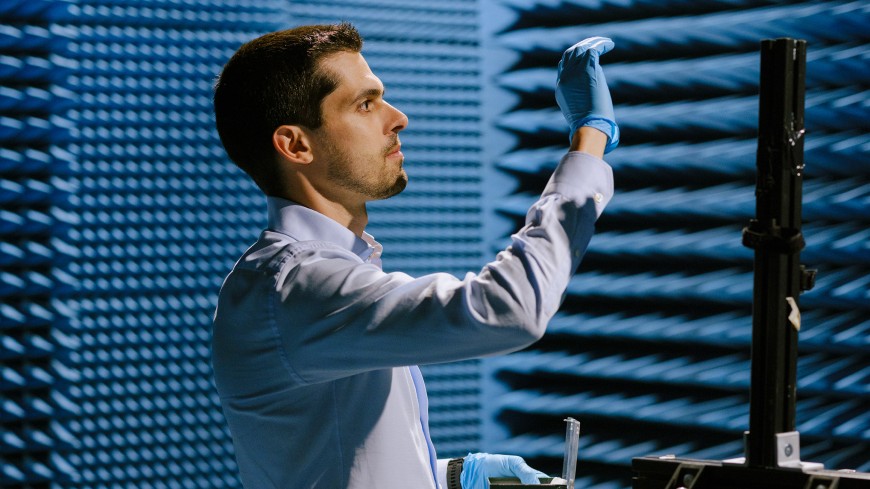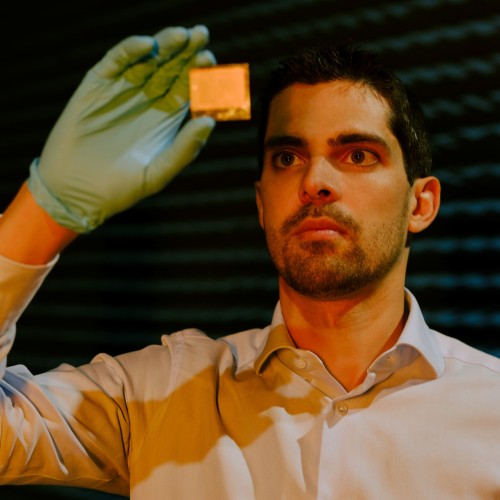Good reception everywhere
Athene Young Investigator Alejandro Jiménez Sáez is investigating how to steer millimeter waves
2023/07/12 by Astrid Ludwig
Dr. Alejandro Jiménez-Sáez, a new Athene Young Investigator at TU Darmstadt, is carrying out research into how millimeter waves could be used in 5G or 6G mobile networks in future in order to improve data transfer rates, offer better protection against eavesdropping and make the networks more flexible. The 30-year old postdoc is investigating which new components will be needed for this purpose and how this technology can be realized.

When Alejandro Jiménez-Sáez is asked to describe his research, he likes to use the concept of a mirror. “Imagine that you could use mirrors in a building to help you look into neighbouring rooms. And these mirrors can also be changed electrically in such a way that you can focus on a particular point in the room in order to, for example, read a book that is open on a table in the next room.”
However, the research carried out by Jiménez-Sáez – who was born in Spain and completed his PhD in electrical engineering and information technology – does not focus on advances in the field of optics but rather on millimeter waves for which there are no mirrors of this type. Millimeter waves have been used in radar technology, motion sensors, WiFi and telecommunication networks for decades but it has only been possible to use them to a very limited extent up to now in the area of mobile communications. Although these so-called “mm-waves” enable high data transfer rates, they only have a short range of a few hundred metres and are highly attenuated by walls. They are thus difficult to receive in buildings.
Therefore, the researcher at TU Darmstadt is investigating how to steer millimeter waves and even how to focus them onto a desired point. “For example, the waves could be focused onto a smartphone or tablet”, explains Alejandro Jiménez-Sáez. And is it perhaps possible under certain circumstances to control these millimetre waves so that they can follow people or mobile devices around? “This would improve the reception considerably and could even make it possible to direct the waves to places where there is otherwise no reception at all”, is how the Athene Young Investigator explains the focus of his research. Jiménez-Sáez, who works in the Department of Electrical Engineering and Information Technology, is searching for the right components and wants to develop methods that will turn this vision into reality.
Dr.-Ing. Alejandro Jiménez Sáez,
Athene Young Investigator
I feel that the university is supporting me on my path to becoming a professor. And it has given new impetus to my academic career.

More affordable solution envisaged
Existing methods are too elaborate and expensive and thus unattractive for network operators. The researcher envisages developing a more affordable solution using basic technology found in the area of display technology. His concept is based on glass slabs and liquid crystal, as can already be found today in televisions, monitors and mobile phones. By adapting this technology to the requirements of millimeter waves, he aims to produce prototypes that can be installed as reflectors – or mirrors – on the internal or external walls of buildings or even as a transparent, controllable lens on a window. The Athene Young Investigator explains that he is currently focussing on the issue of “how this type of surface should be designed”.
He already possesses the scientific expertise necessary. Alejandro Jiménez-Sáez completed his bachelor’s degree in telecommunication engineering at the Polytechnic University of Valencia and spent one year at the Karlsruhe Institute of Technology as part of the Erasmus programme, where he discovered his love for Germany and the German language. He then completed a double degree master’s programme in Valencia and at TU Darmstadt in electrical engineering and information technology. The young scientist was already fascinated by research into novel reflectors and tunable materials at an early stage and his department at TU Darmstadt has been one of the leaders in this field for many years. Jiménez-Sáez completed his PhD at the Institute of Microwave Engineering and Photonics. He was the recipient of the Best PhD Thesis Award in electrical engineering from the Freunde der TU Darmstadt in 2022, after previously receiving awards as the best master student in both Valencia and Darmstadt.
Alejandro Jiménez-Sáez also feels personally at home in the city and at TU Darmstadt. He is a passionate salsa dancer, leads a show dance group and is a dance instructor at the University Sports Centre. The postdoc views the fact that he has now also been selected as an Athene Young Investigator as a “very good step”. He believes that it will make his work more visible, while allowing him to independently carry out his research and gain “more experience and responsibility”. “I feel that the university is supporting me on my path to becoming a professor. And it has given new impetus to my academic career”, he says enthusiastically.
The Athene Young Investigator Programme
The Athene Young Investigator (AYI) Programme at TU Darmstadt supports exceptional researchers on their career path for a period of five years. The aim is to promote the scientific independence of early career researchers and give them the opportunity to qualify for the post of university professor by leading an independent junior research group. The heads of these junior research groups are given certain professorial rights and their own budget.
In 2023, the TU Darmstadt has awarded another four excellent young researchers as “Athene Young Investigators”. In the coming weeks, we will introduce the four researchers on the TU Darmstadt website.






